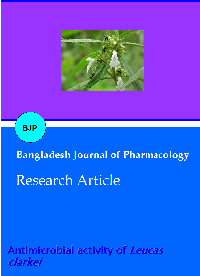Antimicrobial activity of Leucas clarkei
DOI:
https://doi.org/10.3329/bjp.v7i2.10894Keywords:
Antibacterial, Antifungal, Leucas clarkeiAbstract
The antimicrobial potency of the whole plant of Leucas clarkei have been studied using the soxhlet extracts of petroleum ether, benzene, chloroform and ethanol extract against Gram-positive bacteria (two strains), Gram-negative bacteria (two strains) and two fungi strains by disc diffusion method. Micro-dilution methods, for the determination of minimal inhibition concentration (MIC) and the minimal bactericidal and fungicidal concentration (MBC, MFC). The ethanol extract at a concentration of 30 to 60 µg/disc and chloroform extract at a concentration 60 µg/disc showed significant activity against all the bacteria and fungus. All the extracts of L. clarkei have got moderate action but chloroform and ethanol extracts have got significant activity against Candida krusei, Candida albicans, Escherichia coli, Salmonella typhi, Staphylococcus aureus, and Bacillus subtilis. This may be due to phytochemicals such as phytosterols, alkaloid, tannins, phenolic compounds and flavonoids present in the extracts.
Downloads
714
201 Read
52
References
Afolayan AJ, Extracts from the shoots of Arctotis arctotoides inhibit the growth of bacteria and fungi. Pharm Biol. 2003; 41: 22-25.
Aliero AA, Afolayan AJ. Antimicrobial activity of Solanum tomentosum. Afr J Biotechnol. 2006; 5: 369-72.
Bentham G. The genera and species of the plants of the order Labiatae with their general history, characters, affinities and geographical distribution. London, James Ridgway and Sons, 1835, p 602.
Cragg GM, Newman DJ. Medicinals for the Millennia. NY Acad Sci. 2001; 953: 3-25.
Doughari JH, El-mahmood AM, Tyoylna I. Antimicrobial activity of leaf extracts of Senna obtusifolia (L). Afr J Pharm Pharmacol. 2008; 2: 7-13.
Farnsworth NR, Akerele O, Bingel AS. The value of plants used in traditional medicine for drug discovery. WHO. 1985; 63: 965-81.
Haines. Botany, Bihar & Orissa. 1924, p 750.
Harborne JB. Phytochemical methods. A guide to modern techniques of plant analysis. 3rd ed. London, Chapman and Hall, 1998, p 302.
Harborne JB. Phytochemistry. London, Academic Press, 1993, pp 89-131.
Hedge IC. Labiatae. In: Flora of Pakistan. Ali SI, Nasir YJ (ed). University of Karachi, Karachi, 1990, p 192.
Hooker JD. Flora of British India, 1885, p 688.
Kulkarni SK. Handbook of experimental pharmacology. 3rd ed. Delhi, Vallabh Prakashan, 2006, pp 128-31.
Mukerjee SK. A revision of the Labiatae of the Indian Empire. Records of Botanical Survey of India, 14, 1940, pp 1-205.
Nascimento GGF, Lacatelli J, Freitas PC, Silva GL. Antibacterial activity of plant extracts and phytochemicals on antibiotic resistant bacteria. Braz J Microbiol. 2000; 31: 886-91.
Navarro V, Villarial ML, Rojas G, Lozoya X. Antimicrobial evaluation of some plants used in Mexican traditional medicine for the treatment of infectious diseases. J Ethnopharmacol. 1996; 53: 143-47.
Ndukwe IG, Habila JD, Bello IA, Okoh JI. Phytochemical and antimicrobial studies on the leaves and stem of Desmodium scorpiurus Der (sw). Afr J Biotechnol. 2006; 5: 1789-91.
Owoabi J, Omogbai EKI, Obasuyi O. Antifungal and antibacterial activities of the ethanolic and aqueous extract of Kigella africana (Bignoniaceae) stem bark. Afr J Biotechnol. 2007; 6: 882-85.
Reuben KD, Abdulrahman FI, Akan JC, Usman H, Sodipo OA, Egwu GO. Phytochemical screening and in vitro antimicrobial investigation of the methanolic extract of Croton Zambesicus Muell ARG, stem bark. Eur J Sci Res. 2008; 23: 134-40.
Ryding O. Phylogeny of the Leucas Group (Lamiaceae). Syst Bot. 23, 1998, pp 235-47.
Saxena HO, Brahman M. The flora of Orissa. 1950, p 1457.
Sazada S, Verma A, Rather AA, Jabeen F, Meghvansi MK. Preliminary phytochemicals analysis of some important medicinal and aromatic plants. Adv Biol Res. 2009; 3: 188-95.
Sofowora H. Screening plants for bioactive agents. In: Medicinal plants and traditional medicine in Africa. 2nd ed. Ibadan, Nigeria, Spectrum Books Ltd., 1993, pp 134-56.
Sur-Altiner D, Gürkan E, Mutlu G, Tuzlaci E, Ang O. The antifungal activity of Pancratium maritimum. 1999; 70: 187-89.
Swain SR, Sinha BN, Murthy PN. Antiinflammatory, diuretic and antimicrobial activity of Rungia pectinata Linn. and Rungia repens Nees. Indian J Pharma Sci. 2008; 70: 679-83.

Additional Files
Published
How to Cite
Issue
Section
License
Authors who publish with this journal agree to the following terms:
- Authors retain copyright and grant the journal right of first publication with the work simultaneously licensed under a Creative Commons Attribution License that allows others to share the work with an acknowledgement of the work's authorship and initial publication in this journal.
- Authors are able to enter into separate, additional contractual arrangements for the non-exclusive distribution of the journal's published version of the work (e.g., post it to an institutional repository or publish it in a book), with an acknowledgement of its initial publication in this journal.
- Authors are permitted and encouraged to post their work online (e.g., in institutional repositories or on their website) prior to and during the submission process, as it can lead to productive exchanges, as well as earlier and greater citation of published work (See The Effect of Open Access).
